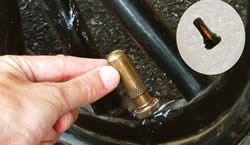Can I Do It With Less?
There is one indisputable lesson that applies to us in manufacturing: We must get more and more functionality out of less and less material. This is the result of continuous improvement, economic competition and the application of engineering principles.
There is one indisputable lesson that applies to us in manufacturing: We must get more and more functionality out of less and less material. This is the result of continuous improvement, economic competition and the application of engineering principles.
“Ephemeralization” is the term coined by R. Buckminster Fuller to describe this phenomenon. It describes the reduction in mass of today’s Buick from the Buick of the 1950s. It describes the difference between a Sony camcorder and a less capable broadcast TV camera of the 1950s or 1960s. Ephemeralization is occurring in every area of our lives.
The term also describes the need for fewer metallic, precision machined parts in the automotive, pneumatic tire application pictured here. With bar brass prices at $40 per 12 feet, how much would the raw material alone cost when compared to today’s low brass content design? The use of USB and Serial connections have made the backplane of today’s computers almost unrecognizable compared to those of 10 years ago. Gone are many of the copper parts needed in parallel connectors.
“Can I do it with less?” is the relevant question in economics, engineering and even ethics. In economics, the question points out the existence of waste and the opportunities to create additional profit. In engineering, which is driven by economics, it helps to achieve more elegant and efficient designs. In ethics, the avoidance of waste means more efficient use of resources. This makes for a more equitable distribution of goods. The result is that greater numbers of people are able to share the benefits from the finite and limited resources currently available.
Can I do it with less? This principle of parsimony impacts our businesses in more ways than just “cutting costs.” Obviously, reducing costs is the explicit lesson of the question. Reducing the mass of precision machined products is another. As raw material prices continue to increase, and as the global markets for products containing precision machined parts continue to grow, the obvious solution is to greatly reduce the mass of the precision machined products while maintaining functionality.
To maintain functionality and improve performance, precision machined products will need to have greater precision, be made from materials with enhanced properties and will likely be greatly reduced in dimension. The implication for our shops is clear: Smaller-diameter capacity machines will be busy. The large-diameter machines will, at best, be “boutique” production capability.
Similarly, the tolerances and allowances in today’s pneumatic tire valve stem are beyond the ability of the producers of the “Model A” valve stem to have even measured. This increase in precision impacts our shops in three ways: 1) the capability of our machines to hold these tolerances, 2) the need for improved means of gaging to ensure that these tolerances are produced and 3) the training of all levels of our shop people to work to these new, extremely challenging quality requirements.
Just as we have seen the reduction in mass, we are also witnessing the reduction in lot sizes. Gone are the annual runs of a million parts each for a couple of major automotive platforms. The segmentation of the markets today, and the savvy engineering that creates differentiated products for these segments, results in a double hit to our bottom line—shorter product runs and increased non-production time for setups.
No longer will the setups for specialized equipment for a year-long-running part be able to be amortized by huge lot sizes. Today’s smaller lots and more frequent setups require equipment with increased flexibility that is able to produce all of the required part characteristics without additional post-machining.
Just as “Can I do it with less?” impacts our utilization and selection of materials, machines and technology, this question also applies to the human side of our businesses. In the current, high-rate-of-change environment for jobs, technology and people, the days of one person specializing on a single type of machine is a luxury that none of us can afford. Specialized knowledge of a single process is not an end in itself. It is the first step toward creating a cross-trained, multi-capability, generalist, can-do workforce.
Can I do it with less? History shows us that indeed we can. The precision machining industry has a long history of adopting new technological innovations to keep our shops competitive and sustainable.
The question for each of us today is, “What have we done to get there?” In other words, “What have we done to make our shops more profitable?” “What have we done to reduce the use of unneeded materials or supplies to keep our businesses lean and sustainable?” “What have we done to eliminate wasted movement and transport in our shops?” “What have we done to help our people grow their capabilities to meet the challenges facing us?”
Now is a great time to start working on the answers to those questions.
— Precision Machined Products Association
Read Next
A Tooling Workshop Worth a Visit
Marubeni Citizen-Cincom’s tooling and accessory workshop offers a chance to learn more about ancillary devices that can boost machining efficiency and capability.
Read MoreDo You Have Single Points of Failure?
Plans need to be in place before a catastrophic event occurs.
Read More5 Aspects of PMTS I Appreciate
The three-day edition of the 2025 Precision Machining Technology Show kicks off at the start of April. I’ll be there, and here are some reasons why.
Read More



















